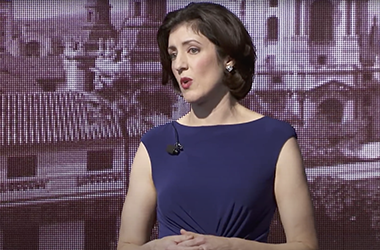Social Security: Neutral in Name, Sexist by Design

 Soon after we had our daughter, I read that elderly women receive far lower Social Security benefits than men due largely to motherhood. Having just become one, I visited the Social Security Administration website. At the top of the page, they reassured me “Social Security is neutral with respect to gender.”
Soon after we had our daughter, I read that elderly women receive far lower Social Security benefits than men due largely to motherhood. Having just become one, I visited the Social Security Administration website. At the top of the page, they reassured me “Social Security is neutral with respect to gender.”
I proceeded to use their calculator to find out if my Social Security benefits would be affected if I were out of the workforce for five to seven years to care for our daughter.
Response? I would lose a half-million dollars. That didn’t sound so “gender neutral” to me.
And that’s because Social Security is neutral in name only, by design it is sexist. Social Security was designed in the late 1930’s by a council that used the beliefs of the time about men, women, money and work to guide their recommendations. Their beliefs were far from neutral and instead included:
- Women should be discouraged from employment. One council member noted approvingly that the proposal would “take away the urge [of married women] to go back [to work].”
- Men can’t take care of themselves and should be compensated for that. One council member argued for lower benefits for widows since a single woman can live more cheaply than a single man because “she is used to doing her own housework whereas the single man has to go out to a restaurant.” And also because the elderly single woman can “avail herself of the home of the child” because “the grandmother helps in the raising of the children” while “the aged grandfather is the man who sits out on the front porch and can’t help much in the home.”
- Men should be compensated for having dependent wives to take care of him. A member of the council defended the proposal to provide an extra “Wife’s Benefit” by noting “that you are doing something real for the man who would enjoy the security of the additional income.”
The only reason today’s Social Security Administration can claim to be “gender-neutral” is thanks to the efforts of Ruth Bader Ginsberg. When she was a practicing attorney, she argued a series of Supreme Court decisions in the late 1970’s which:
- Changed the name of the “Wife’s Benefit “ to the “Spousal Benefit.” And made men eligible for the “Spousal Benefit” if they earned less.
- Changed the distribution of benefit checks. The check for the “Wife’s Benefit” had always been written to her husband’s name and sent to him. Checks for the “Spousal Benefit” are now written and sent to that spouse.
These are important changes, but did nothing to change the underlying sexist design of the program and the different outcomes for men and women based on their different employment patterns.
Social Security still operates as it was intended in the late 1930’s. My own benefits are calculated based on the number of years I am employed and the amount I earn. The more years and the higher the wages, the higher my retirement benefit. The years I spent out of the workforce with our baby add several zeroes to the calculation, dragging down my benefit amount. The years I may spend working part-time or in a lower paying flexible job to care for family also decrease my benefits. While more women than ever are employed today and more fathers are caregivers, it is still far more common for women to give up earnings to care for family than for men, so women still end up with lower Social Security benefits.
Similarly, wives are still more often the lower earner in a couple. And as the lower earner in my family, at retirement I will be eligible to take either a “Spousal Benefit” equal to 50% of my husband’s benefit or the benefits I earned on my own whichever is greater. So I could work for pay for many years, contributing taxes to Social Security, yet if he earns more I will still end up taking the same 50% benefit I can get if I’m never employed at all. Employment doesn’t get me any greater Social Security benefit, helping to “taking away my urge to go back to work.”
When my husband and I retire, we will receive 150% of his benefit amount in two checks. One check for 2/3 of that total arrives in the mailbox in a check to him, his 100%. Thanks to Ms. Ginsberg, another check arrives for me for 50% of his benefit, but I control just 1/3 of our total. If we get divorced, he still gets his check for 2/3 of that total benefit. I will have to get by on my Spousal Benefit check for 1/3 of the total, because remember I’m supposed to be “used to doing my own housework” while he “has to go to a restaurant.”
What is even more infuriating is that two simple changes, both of which have been proposed for years, could make Social Security equitable for men and women, spouses, and anyone who gives up earnings to care for family members.
One, add a Caregiver Credit for a finite number of years a person spends out of the workforce caring for children, or for disabled or elderly family members. As recently as April Michael Hiltzik in the Los Angeles Times wrote about this common recommendation, which was also re-introduced into Congress in June 2011. Instead of zeroes for the years I stayed out of the workforce, I would be credited for say $20,000, about half the median wage in the United States. When I retire, instead of having five zeroes averaged into my calculation, I have credits for every year and benefits comparable to anyone who has a consistent employment history.
Two, lose the Spousal Benefit and replace it with “earnings sharing” for spouses. “Earnings sharing” would add the two spouses’ incomes together and then credit half of that total to each spouse within Social Security. For example, in a year that I was out of the workforce, if I received the Caregiver Credit for $20,000 and my husband earned $54,000, then our total credits for Social Security would be $74,000. We would split them down the middle and each of us would receive $37,000 credit toward Social Security for that year. Then at retirement, we each would receive a check for half of the benefits earned during the marriage. In the event of divorce, our credits would already have been divided equally during the marriage and our respective checks would still reflect that split. Earnings sharing is not a radical notion. A member of the Social Security Council proposed it back in the late 1930’s. The council rejected it in favor of the “Wife’s Benefit” paid to the husband to care for his wife as his dependent, so he “would enjoy the security of the additional income.”
Now, when Social Security is front and center in our political dialogue, now is the time to make changes so that the Social Security Administration can honestly announce on its website “Social Security is neutral with respect to gender – by design.”
Catalyze!
- For a simple introduction to how Social Security works read and share my article Social Security and Today’s Mother written for Mothers & More, updated and reprinted this month in the Mothers & More Forum.
- Representative Nita Lowey introduced H.R. 2990 Social Security Caregiver Credit Act of 2011 in June 2011. Track it here and contact Rep Lowey and your Representative with your support. Click through the POPVOX button to register your support publicly and have it sent to your Representative.
- Earlier in May, a national coalition of organizations issued a report urging Congress to consider major changes to Social Security, including caregiver credits and increasing widow/widower benefits.
- In 2005, when George W. Bush made a push to privatize a portion of Social Security, I wrote this analysis advocating that any reform adhere to three principles: equity for equal earning couples, equity between spouses in a marriage, and counting unpaid care work as a contribution to society and the economy. Read and share The Real Social Security Crisis.



I agree 100%. We talk a good talk in this country about the importance of moms and families, but we sure don’t back it up.
You are so right. I think a lot of people are completely unaware how sexism is built into our outdated public policy infrastructure.
Kristin